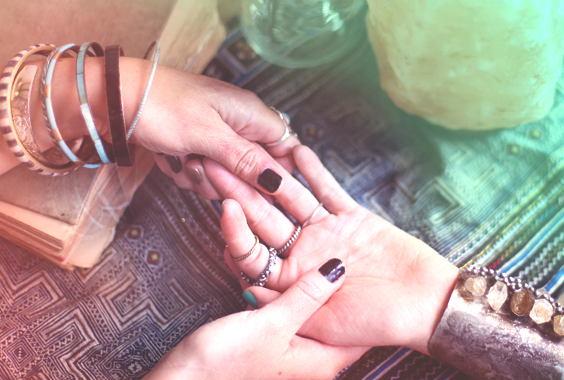There's an illusion that's become a kind of pet experiment
有一种错觉已经成为实验的宠儿
that's used all over the world by psychologists who like spooking people.
世界各地喜欢吓唬人的心理学家都做过这个实验。
Here's how it goes:
实验是这样的:
You sit at a table and hide one hand behind a divider, with a blanket draped over your shoulder.
你坐在桌子旁,一只手藏在隔板后面,肩上披着一条毯子。
There's a fake hand on the table,
桌子上放只假手,
and the experimenter arranges it so the fake hand's wrist looks like it's connected to you.
实验人员做出安排让假手手腕看起来好像是你的。
Then, you watch the fake hand as the experimenter strokes both your hidden,
然后,实验者以同样的方式抚摸隐藏的手(真手)
real hand and the fake hand in exactly the same way.
和假手,你看着假手,
After a few seconds, you start to get the sense that the fake hand is actually your own.
几秒钟后,你开始有种假手才是你的手的感觉
That's when the experimenter grabs a hammer and whacks the fake hand with it,
此时,实验人员拿起锤子敲打假手,
which makes you recoil in panic.
这会让你恐慌,不自觉地退缩。
And yeah, it's kind of mean, but this illusion has actually turned out to be super useful.
是的,这有点残忍,但这个错觉实际上非常有用,
It's helping programmers create better virtual realities,
它可以帮助程序员创造更好的虚拟现实,
and it's also being used in medical treatments.
该错觉也用于医学治疗,
The trick is called the rubber hand illusion,
我们称之为橡胶手错觉,
and it was first published by a group of researchers back in 1998,
于1998年首次由一组研究人员发表,
when they discovered that if your real hand is hidden,
他们发现,如果真手藏了起来,
you can convince your brain to adopt a fake hand as your own.
你可以说服大脑把假手当成自己的手。
And there's a good reason why your brain just misplaces a part of your body
这就是为什么你的大脑会将
you've known and loved your entire life.
你所知并一生爱着的部分身体放错地方的原因。
It has to do with multisensory integration:
这与多感官整合有关:
when your brain takes information from all of your senses and puts it together to create one cohesive picture of the world.
大脑将所有感官信息组合在一起,创造一个有凝聚力的世界图景。
Usually, your brain can do this really well, and your perceptions are pretty accurate.
通常情况下,大脑在这方面会做的很好,你的感知也相当准确。
Sometimes, though, the process can go wrong,
但有时候,这个过程可能会出错,
because your brain trusts certain kinds of sensory input more than others when it's building that big picture.
因为大脑在构建世界图景时会相信某些感官的输入。
In this case, it gives more weight to what you're seeing with your eyes and feeling with your skin.
在这种情况下,大脑更加注重视觉和触觉。
So you see the fake hand in the spot where your real hand should be, looking like ...
所以,你看着位置上的假手(本来应该放置真手),看起来像
... well, a hand, and you feel touches that match what you see happening to the fake hand.
…好吧,是手,感知着你从假手上看到的相同触觉。
Your brain trusts that more than your proprioception—the sense telling you where your hand actually is in space.
你的大脑相信的不仅仅是你的本体感觉——手在空间中的实际位置,
So it just corrects your proprioception to match what it thinks is the most accurate version of what's happening.
它只是在纠正你的本体感觉以匹配大脑对正在发生的事情最准确的描述

That's why you feel like the fake hand is yours, even though you know it's not real, and you react to the hammer.
这就是为什么你觉得那只假手是你的,即使你知道那不是你的手,也会对锤子做出反应。
But the rubber hand illusion is useful for more than just scaring people.
但是橡胶手的错觉不仅仅吓唬人有用。
Researchers can also use it to make virtual reality, or VR, seem more realistic.
研究人员还可以利用它来让虚拟现实更加真实。
In a 2010 study, for example,
例如,2010年的一项研究中,
computer scientists from University College London tested
伦敦大学学院的计算机科学家们测试了
whether the rubber hand illusion would make it seem more like you'd actually stepped into a simulated world.
橡胶手错觉是否会让人走进虚拟世界的感觉更加真实。
They had 20 university students use VR headsets and controllers to experience different simulations.
研究人员让20名大学生使用VR耳机和控制器来进行不同的模拟体验。
Then, the researchers monitored their reactions to the simulations using both questionnaires
然后,使用两份问卷来监测他们模拟时的反应,
and what's known as galvanic skin response,
这就是所谓的皮肤电反应,
which measures the intensity of your emotional responses based on how much you're sweating.
根据出汗多少来测量情绪反应的强度
They found that when the simulation included virtual arms that were in danger of being injured,
他们发现,当模拟有受伤危险的虚拟武器时,
the players' alertness spiked.
队员们的警觉性提高了。
They were bracing their own bodies for impact, as if they were actually about to be hurt.
他们用自己的身体来抵抗冲击,就好像他们真的要受伤一样。
But they didn't tend to brace themselves that way when the simulation just had plain arrows instead of virtual arms.
但是当模拟仅仅有纯箭头而不是虚拟的手臂时,他们就不会那样做了。
Since this was a small study,
因为这是一个小型研究,
there's still a whole lot we don't know about how the rubber hand illusion applies to virtual reality,
我们还不知道橡胶手的错觉是如何应用到虚拟现实中的,
but the experiment been replicated by other researchers since then, with similar results.
但从那以后,其他研究人员也进行了同样实验,得到的结果相似。
Studies like this could pave the way for new techniques and hardware for more realistic simulations—
这样的研究可以为更真实的仿真模拟做好新技术和硬件准备——
and that would be useful for more than just awesome video games.
这将不仅仅适用于电子游戏。
Realistic, immersive simulations might also help people in physical therapy,
身临其境的仿真模拟也可能帮助患者进行物理治疗,
since you can have patients try exercises in ways that would be impossible in the real world—
因为病人可以尝试现实生活中不可能进行的锻炼——
if you set up a simulation with less gravity, for example.
例如低重力的模拟训练。
And a version of the rubber hand illusion is already being used in another kind of therapy, called mirror box therapy.
橡胶手错觉已经用于另一种称为镜盒疗法的治疗当中,
It's used to treat phantom limb pain, where people feel pain from a limb that's been removed,
用其治疗幻肢疼痛——切除肢体的疼痛感,
as though it's still a part of their body.
治疗时好像肢体仍然是身体的一部分。
Phantom limb pain is especially hard to treat, because ... there's nothing there.
幻肢疼痛特别难以治愈,因为…没有肢体在那儿。
Mirror box therapy uses a box with a mirror on it,
镜盒疗法通过使用带有镜子的盒子,
set up to reflect the patient's remaining limb in a way that makes it look like the missing limb is actually there.
来反射病人的剩余肢体,使缺失的肢体看起来并没有缺失。
As the patient looks at the reflection,
当病人看着镜子中的反射时,
they do stretches and exercises with their remaining limb.
用剩余的肢体做伸展运动。
Their brain reads what they're seeing in the mirror as the missing limb moving, stretching,
当缺失的肢体移动伸展时,他们的大脑会读取镜中的信息,
and generally being healthy, and turns off the painful alarm bells.
一般来说都是健康的,大脑痛苦的警钟就会关闭。
Dozens of studies have tested mirror box therapy, and they've found that it does work.
镜盒疗法已经研究测试过,他们发现该疗法确实有效。
So the rubber hand illusion may be a weird cognitive flaw.
所以橡胶手错觉可能是一种不可思议的认知缺陷。
But by exploiting it, we can create some amazing virtual worlds—
但是通过该错觉,我们可以创造神奇的虚拟世界——
and hopefully help people with rehabilitation and pain, too.
也希望能帮助病人康复,减轻疼痛。
Thanks for watching this episode of Scishow Psych,
感谢收看本集心理科学秀,
and thanks especially to our patrons on Patreon for making this show possible.
特别感谢Patreon对本节目的支持。
If you want to support this show, just go to patreon.com/scishow.
如果您想支持我们的节目,那就访问patreon.com/scishow吧。
And don't forget to go to youtube.com/scishowpsych and subscribe!
别忘了登陆youtube.com/scishowpsych订阅我们的节目哦


